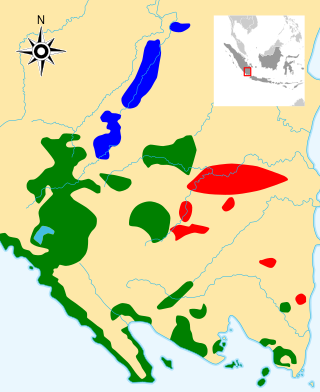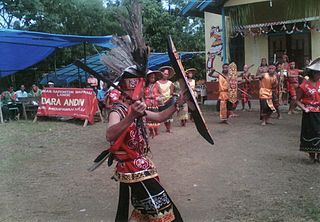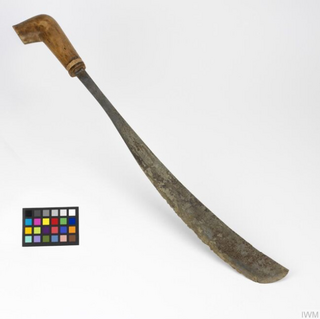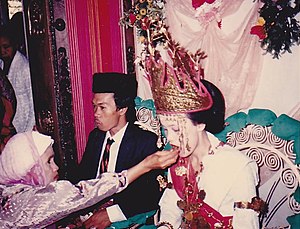
Lampung, officially the Province of Lampung, is a province of Indonesia. It is located on the southern tip of the island of Sumatra. It has a short border with the province of Bengkulu to the northwest, and a longer border with the province of South Sumatra to the north, as well a maritime border with the province of Banten and Jakarta to the east. It is the original home of the Lampung people, who speak their own language, and possess their own written script. Its capital is Bandar Lampung.
The Batin are a sub-group of Malay people that inhabits the interior parts of Jambi province

Lampung or Lampungic is an Austronesian language or dialect cluster with around 1.5 million native speakers, who primarily belong to the Lampung ethnic group of southern Sumatra, Indonesia. It is divided into two or three varieties: Lampung Api, Lampung Nyo, and Komering. The latter is sometimes included in Lampung Api, sometimes treated as an entirely separate language. Komering people see themselves as ethnically separate from, but related to, Lampung people.

The Kendayan are an Indonesian ethnic group native to Kalimantan, Indonesia in Borneo. The population of the group is around 366,000.

The Bantenese are an indigenous ethnic group native to Banten in the westernmost part of Java island, Indonesia. The area of Banten province corresponds more or less with the area of the former Banten Sultanate, a Bantenese nation state that preceded Indonesia. In his book "The Sultanate of Banten", Guillot Claude writes on page 35: “These estates, owned by the Bantenese of Chinese descent, were concentrated around the village of Kelapadua.” Most of Bantenese are Sunni Muslim. The Bantenese speak the Sundanese-Banten dialect, a variety of the Sundanese language which does not have a general linguistic register, this language is called Basa Sunda Banten.
The Ulu scripts, locally known as Surat Ulu are a family of writing systems found in central and south Sumatra, in the regions of Kerinci, Bengkulu, Palembang and Lampung, Indonesia. They were used to write manuscripts in Sumatran languages and Malay, such as the Tanjung Tanah Code of Law. The Malay writing was gradually replaced by the Jawi script, a localized version of the Arabic script.
Lawangan is an Austronesian language of the East Barito group. It is spoken by about 100,000 Lawangan people living in the central Kalimantan, Indonesia. Lawangan has a high degree of dialectal diversity.

Tanggamus Regency is a regency (kabupaten) of Lampung Province, Sumatra, Indonesia. It has an area of 4,654.96 km² and had a population of 534,595 at the 2010 Census and 640,275 at the 2020 Census; the official estimate as at mid 2022 was 652,898. The regency seat is the town of Kota Agung Pusat. The regency was created on 21 March 1997, but districts in its eastern part were split away on 29 October 2008 to form a new Pringsewu Regency. It lies in the southwest of the province, and surrounds Semangka Bay on its west, north and east coasts.

Gorontalo people, also known as Gorontalese are a native ethnic group and the most populous ethnicity in the northern part of Sulawesi. The Gorontalo people have traditionally been concentrated in the provinces of Gorontalo, North Sulawesi, and the northern part of Central Sulawesi.

The Kanta is a traditional shield of the Toraja and Pamona people of Tana Toraja Regency, South Sulawesi and Poso Regency, Central Sulawesi, Indonesia respectively.

Rangkiang is a granary or rice barn of the Minangkabau people used to keep rice. The rangkiang is a distinctive feature of Minangkabau architecture. The structure is traditionally found in the courtyard of a rumah gadang, the traditional house of Minangkabau people.

Baduy is one of the Sundanese-Baduy languages spoken predominantly by the Baduy people. It is conventionally considered a dialect of Sundanese, but it is often considered a separate language due to its diverging vocabulary and cultural reasons that differ from the rest of the Sundanese people. Native speakers of the Baduy language are spread in regions around the Mount Kendeng, Rangkasbitung district of Lebak Regency and Pandeglang Regency, Banten Province, Indonesia. It is estimated that there are 11,620 speakers as of 2015.

Banten Sundanese or Bantenese is one of the Sundanese dialect spoken predominantly by the Bantenese —an indigenous ethnic group native to Banten— in the westernmost hemisphere of Java island, and in the western Bogor Regency, as well as the northwestern parts of Sukabumi Regency. A variety of Bantenese is spoken by the Ciptagelar people in the Kasepuhan Ciptagelar traditional community in the Cisolok district and the Kasepuhan Banten Kidul traditional community in the Lebak Regency.

Islam in Central Sulawesi, a province of Indonesia, is the majority religion embraced by around 75% of the province's 2,683,722 inhabitants . The propagators of Islam were thought to enter Central Sulawesi through neighboring regions, namely Bone, Wajo, and Mandar from the south and west routes, and through Gorontalo and Ternate from the north and east routes via Tomini Bay and Tolo Bay.
A Pujungan Inscription, also called Bronze Tongtong Inscription, is a short inscription written on a copper slit drum, which was found in the village of Pujungan in Pupuan District, Tabanan Regency, Bali, Indonesia. This inscription is thought to have been written during the reign of King Anak Wungsu in the 11th century. This is the first inscription that mentions the name Sasak, the name of the indigenous people of Lombok island.
Tuanku Panglima Paderap, also called Panglima Deli, was the third ruler of the Deli Sultanate, now part of North Sumatra, Indonesia. He succeeded his father Tuanku Panglima Perunggit, who died around 1700. Paderap had four sons, namely Tuanku Jalaluddin, Tuanku Panglima Pasutan, Tuanku Tawar, and Tuanku Umar.
Lembak people, also known as Linggau people, are a local ethnic group that inhabits several areas of Bengkulu Province and South Sumatra Province in Indonesia. Their original settlements are in the border area between the two provinces, in the Barisan mountain range, with densely clustered villages pattern.

Penai is a machete-like sword found in Sulawesi, Indonesia. Traditionally, it is used for both war and agricultural tools. It is used by the Bare'e speaking Torajan people and Pamona people.

The Tangkin is a traditional parang (knife) of the Iban people from Sarawak, Malaysia and West Kalimantan, Indonesia.

















